 I think it’s time to work this tree. If for nothing else but to put it into a proper pot.
I think it’s time to work this tree. If for nothing else but to put it into a proper pot.  You know, there’s a real history and tradition of containers like this being used for native collected material. Mary Madison uses these trays all the time with her collected buttonwood. It’s a small cat litter box from Walmart. Drill a few holes and you have a nice training container.
You know, there’s a real history and tradition of containers like this being used for native collected material. Mary Madison uses these trays all the time with her collected buttonwood. It’s a small cat litter box from Walmart. Drill a few holes and you have a nice training container.  I’ve just had it a bit too long in the Florida sun.
I’ve just had it a bit too long in the Florida sun.
The tree is a southern hackberry, which I think I’m going to say is my favorite deciduous tree, at the moment. It’s native to florida, it grows fast and develops branching quickly (those two things are not mutually exclusive, by the way….) They’re easy to collect with about a 100% survival rate, and they just look so cool, with that fine branching, rough bark, small leaves. I love them.
They’re easy to collect with about a 100% survival rate, and they just look so cool, with that fine branching, rough bark, small leaves. I love them.
And I say “To hell!” to the japanophiles who say native trees, like these, aren’t good for bonsai. You can follow the full development of one of my real signature trees starting at this post. If that tree isn’t bonsai, then nothing in the USA is.
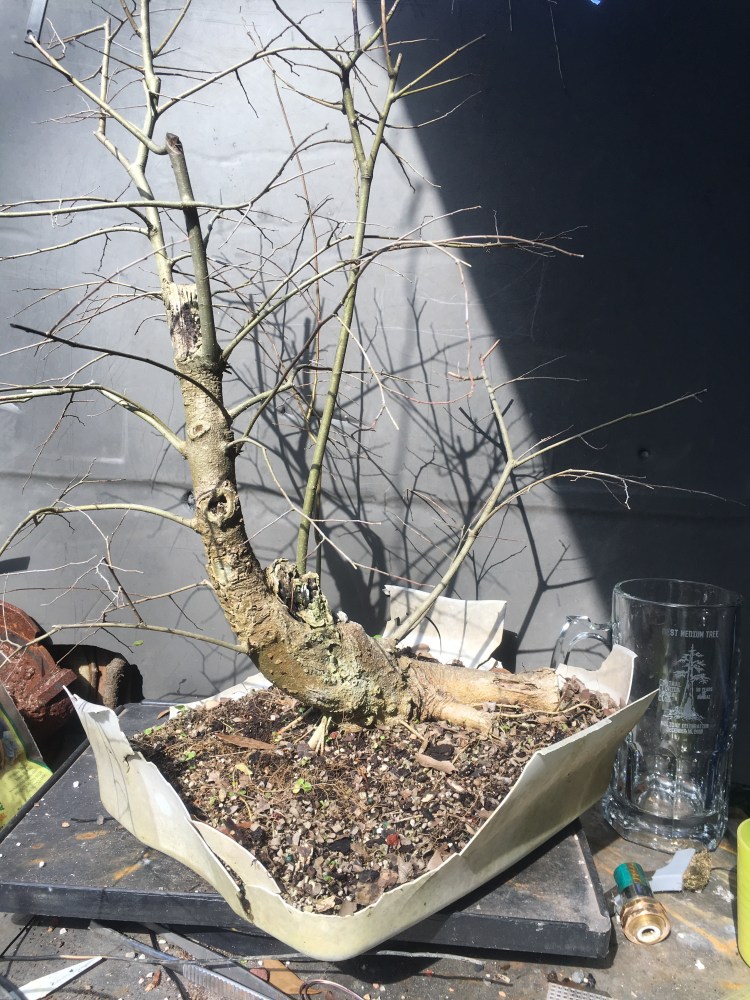 The hackberry I prefer is celtis lævigata. Technically, it’s a “sugarberry”, but as I’ve said before, I prefer the common name “southern hackberry”. But common names don’t really matter, for example, on the USDA care sheet, one of its common names is, in Spanish, “Palo blanco”. Which means, literally, white stick.
The hackberry I prefer is celtis lævigata. Technically, it’s a “sugarberry”, but as I’ve said before, I prefer the common name “southern hackberry”. But common names don’t really matter, for example, on the USDA care sheet, one of its common names is, in Spanish, “Palo blanco”. Which means, literally, white stick.
This root spread kinda shows how the tree grows. It’ll put up “suckers” from the roots, and those shoots can and will become their own trees The tree was a root sicker at one point.
The tree was a root sicker at one point.
Look on the roots on the far left. That’s a sucker popping up from the root.  Most designers would remove that, but I’m keeping it. I’m going to use it in the design to show the nature of the tree.
Most designers would remove that, but I’m keeping it. I’m going to use it in the design to show the nature of the tree. 
It’s a tit-bit-nipply tonight in Orlando, so fire for this cold night is in order. The Nook is just a roof and a bunch of crap that needs organizing, not much in the way of shelter from the cold (there is the Wall of Pots too, but that doesn’t provide much protection).  Ahhhhhh, Fire!
Ahhhhhh, Fire!
getting back to the tree, I think this is the front. 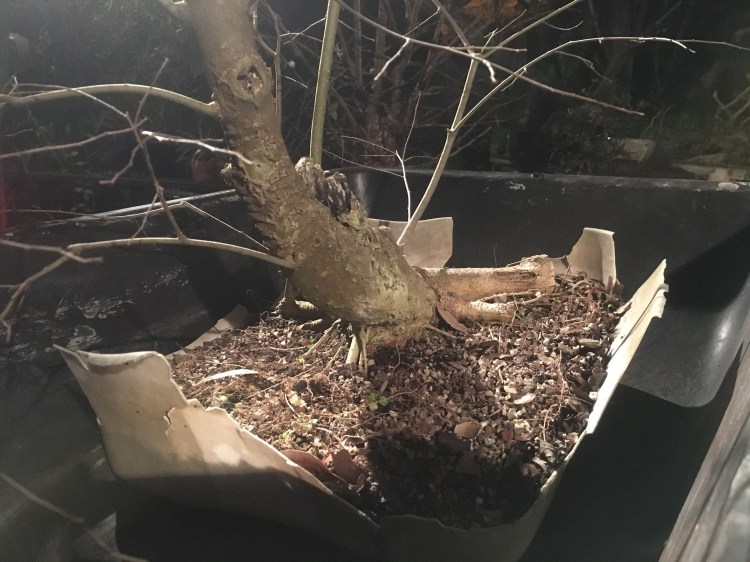
I hate to throw this away, I’ve been looking at it for about 4 years. It’s become a staple of the nursery.  Four or five years is generally how long I’ll give a collected tree time to regain its energy before I begin to look at it for bonsai. Don’t rush your trees. Unless you can…..
Four or five years is generally how long I’ll give a collected tree time to regain its energy before I begin to look at it for bonsai. Don’t rush your trees. Unless you can…..
Using my handy dandy, homemade root hook….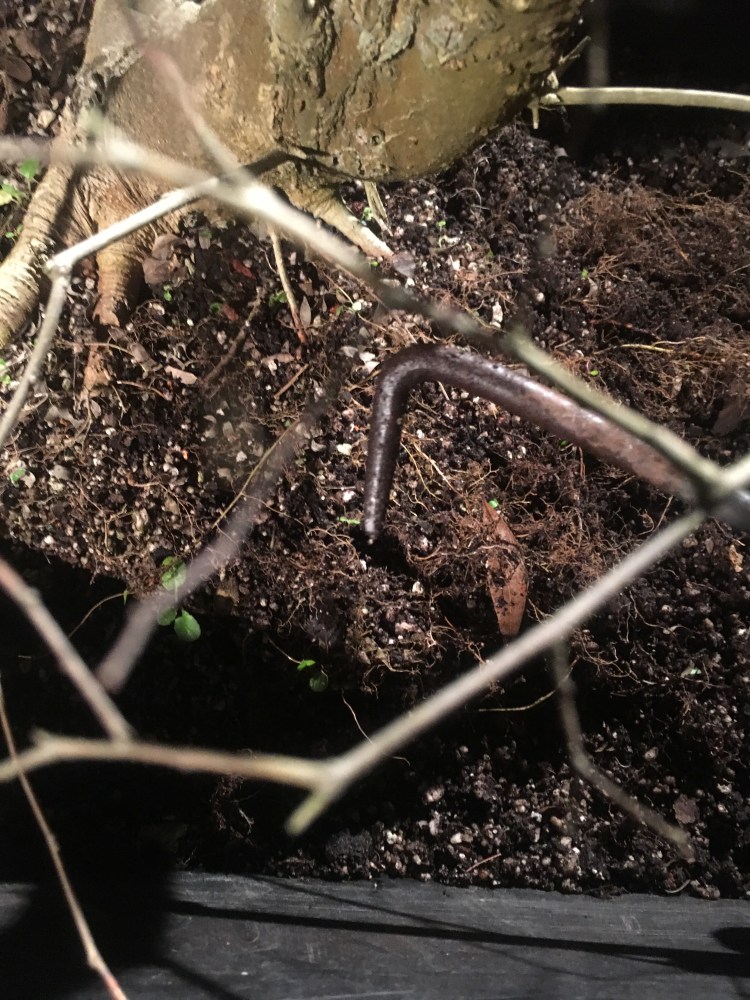
Of which mine is a superior design, of course (the loop for the handle goes under, giving you a more secure grip and providing for a more ergonomic experience….)
We have some side roots! I must have known what I was doing when I collected this tree. This is a good place for an aside: I know how much you want to collect some trees, and really begin to be like your idols like Mauro or Harry, but look at the material they collect and what you might collect. Find the tree with character, uniqueness, interest. If all you can find is a straight boring trunk, you’re better off buying one at a tree farm. It has a better chance of surviving, and you’re. Or removing a tree from nature.
The trees I collect are along a highway and they’re not wanted by the Dept of Transportation. Many have been bush-hogged down to make it easier for the mowers and maintenance men to keep the road up.  Find something interesting.
Find something interesting.
Here’s a tip, I know we want to preserve as many surface roots as we can, but wispy ones like this are out of scale (bonsai is an art of deception, with scale being one of those tools we use). 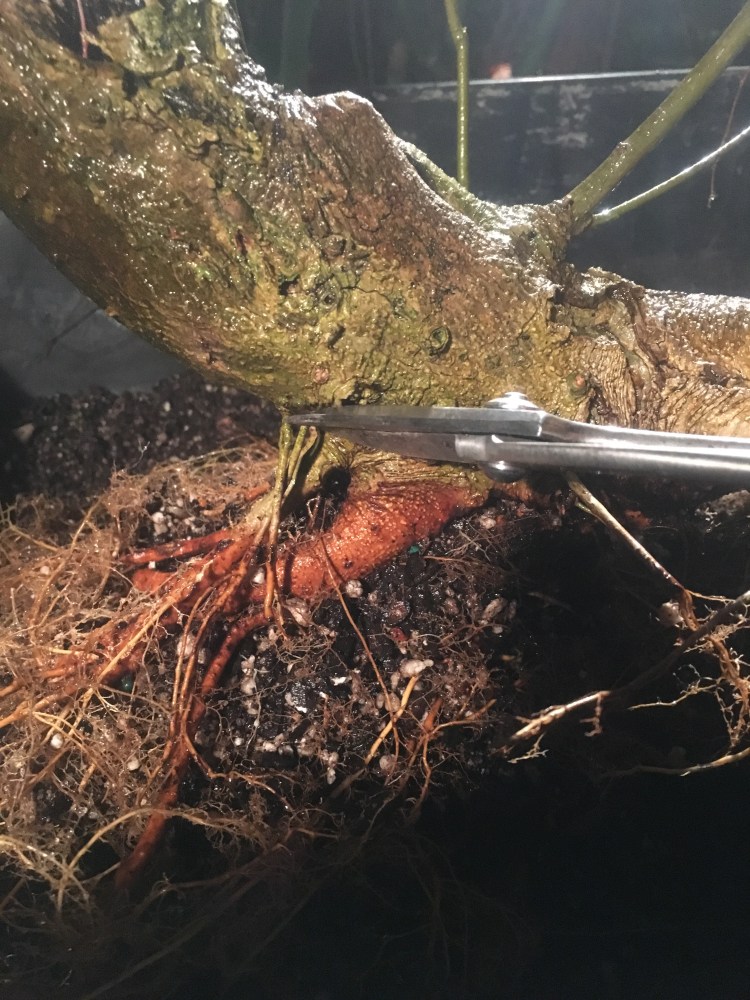 Get rid of them and use the larger roots.
Get rid of them and use the larger roots. 
But, I won’t be wasting those roots I just cut off though, hackberry are one of the trees you can use for root cuttings. I have time (hopefully) where I’ll see a tree from this. But if not, it can still be given away to a newbie, or donated to a club raffle.  We need more trees in the world.
We need more trees in the world.
the pot I’m using one I got many years ago from Paul Pikel.  I think it’ll work here. Good depth, big enough to hold the tree….
I think it’ll work here. Good depth, big enough to hold the tree….
Now then, let’s do some styling. 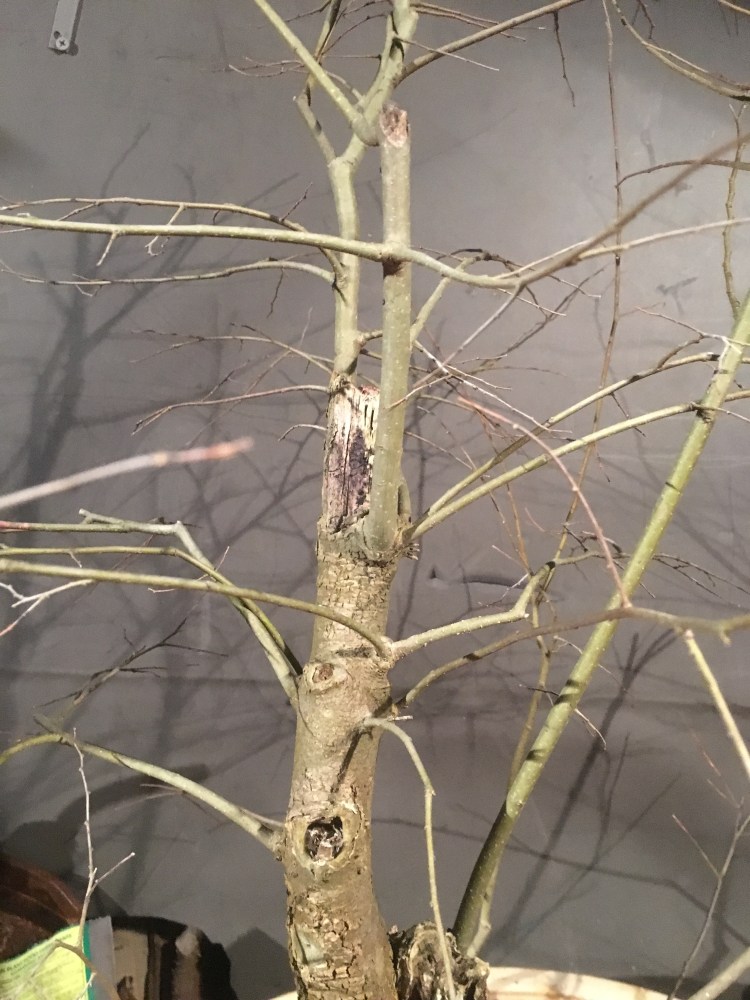
For some reason, the tree grew two apexes (its both apexes or apices, btw. I like apexes, unless I’m trying to sound hoity toity, then I’ll say apices. Kinda like when that bonsai dude says “inverse taper” or “substrate”). 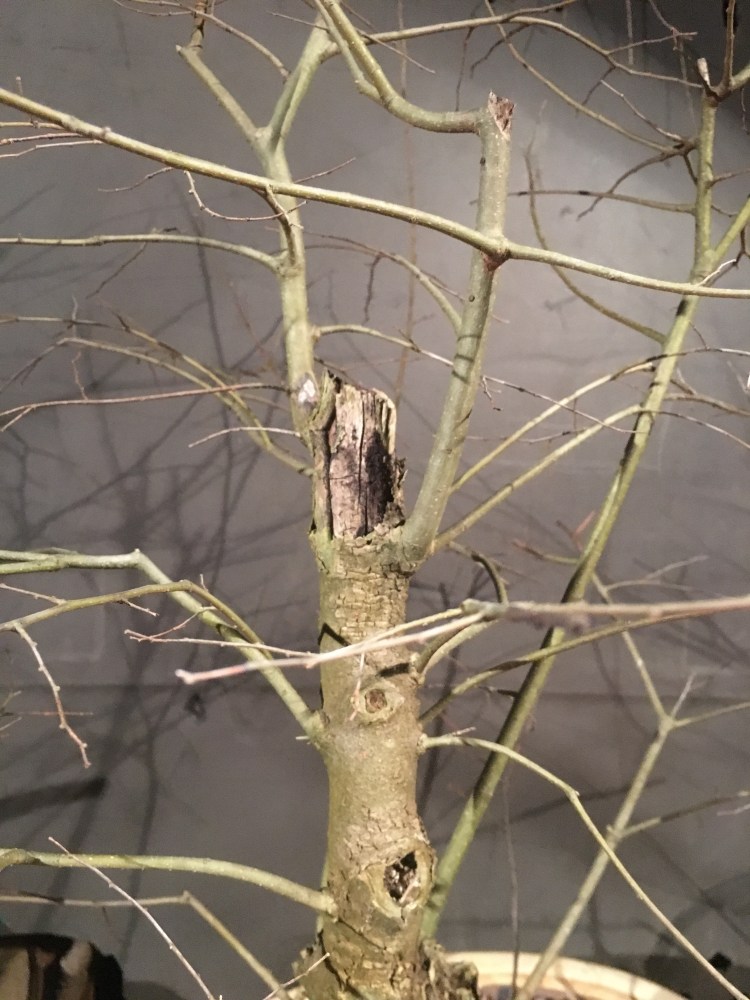
Which will be the top?
Hither?
Or yon? 
I think I’ll go with yon….
Awwwwww…….
……SNAP!!!!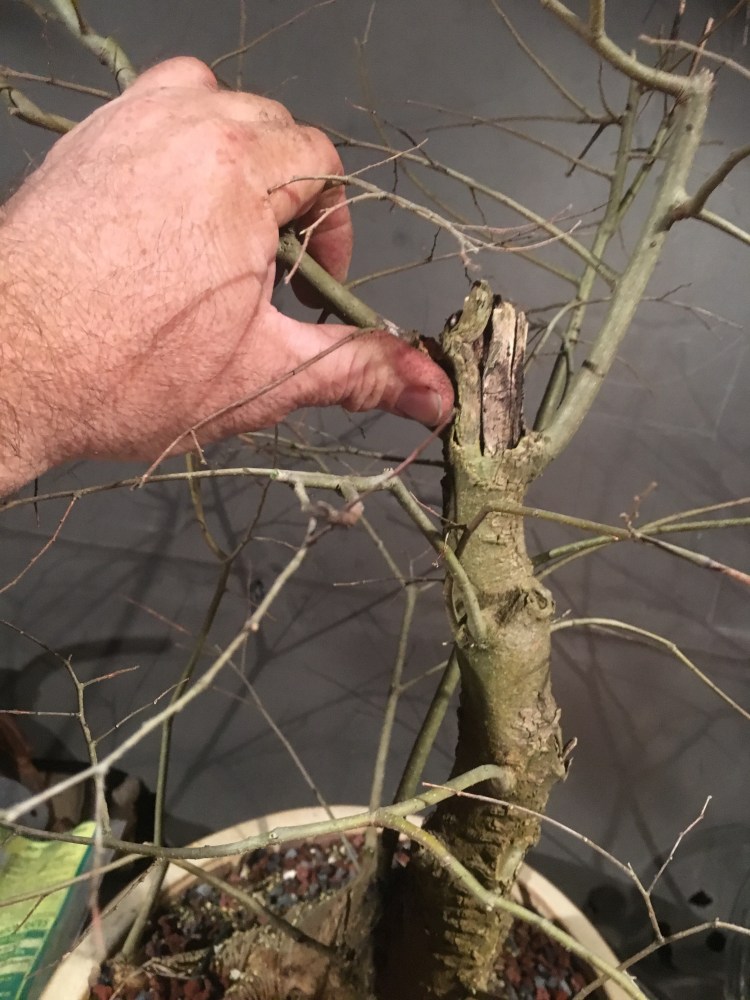
Yes, I did just break that off. 
And here’s proof. Like a gnawed down chicken bone. 
Hackberry doesn’t heal wounds like this very well. And to match the cut, why not rip it off? It works.  We are trying to make old looking trees, and one with a big wound on it certainly looks old.
We are trying to make old looking trees, and one with a big wound on it certainly looks old.
Almost done, just need to prune off some more branches for taper and then add a little wire. This is the first styling so I won’t be loading it up with fine wiring.
Here’s that root sucker I left. 
This is another strong shoot that needs some cutting back. 
The top needs some taper……. ……heavy wire…. .
……heavy wire…. .
Heavier wire to move that apex….
And almost…..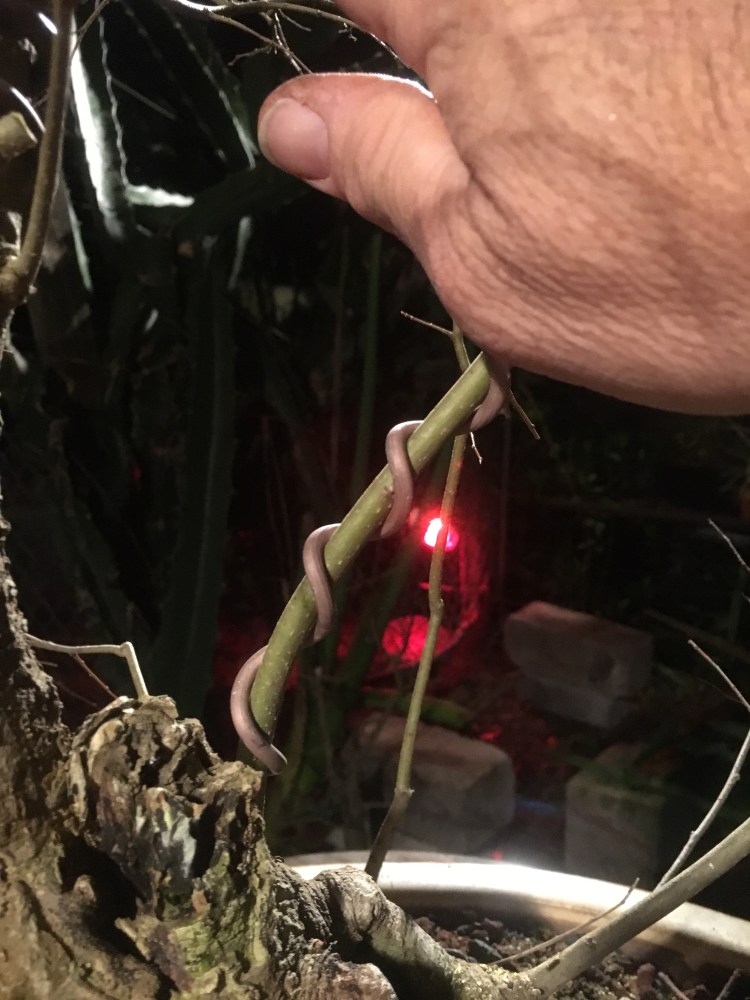 There!
There!
That’s all I can do. I like it too. 
Like the hackberry post I linked to above, this post is the beginning of the journey for this tree. Book mark it for future reference.
I’m excited!
Oh, about the title, a yamadori is technically a tree collected in the mountains (literally it’s actually a mountain bird, the copper pheasant (Syrmaticus soemmerringii) but Japanese is weird where they use words in niche ways. Take the word sake, in sushi culture, its salmon. I can see some Japanese dude who was a little shy about playing with little trees telling his friends he was going to the mountain “hunting pheasants”)
So a hackberry tree collected in a drainage ditch in a state that’s at sea level (give or take) doesn’t really qualify as being in the mountains. But the word, much like the word bonsai, has changed. Nowadays we call any collected tree a yamadori.
One last bit of housekeeping, and I hate to do it, but…..this blog costs me $300 a year to maintain the database with unlimited storage. I need to figure out a way to pay that. This is where you, the readers, come in:
How can I do it? I don’t want to run adds but I may need to (it won’t be Adsense or any of those, I would vet each ad myself and add them in not so blatant areas). Send me some ideas to adamaskwhy@att.net, help me figure it out.
Thanks!
How does the common hackberry compare to the southern for bonsai culture?
LikeLike
I can only comment with my experience here in Florida with one specimen, and it doesn’t like Florida much. I think in Orlando it’s at the southernmost range and it just doesn’t grow. It’s celtis occidentalis
LikeLike
Reblogged this on Wolf's Birding and Bonsai Blog.
LikeLike
You should switch your website to something free like, a hugo or jekyll statically generated site and host it for free on github and netlify. You would then only pay for your domain name. Feel free to contact me for help.
LikeLike
I have too many gigabytes for the free platforms. I’m using WordPress and it’s unlimited storage at the business level. As well as free themes and free support
LikeLike
The architecture I mention is not limited by size and would be free as long as the code for the website is open source, which I don’t see being an issue. If you want to throw out the idea before trying it then, cheers! If you want to explore it, then let’s chat.
LikeLike
For $300 it is probably worth investing a little time into learning how to use a static site generator like jekyll, hugo, or gatsby. You would end up only paying for your domain name. I could show you how to host the website on github and have it published to netlify and hosted for free. I’d be happy to help you out.
LikeLike
Surprised no one has mentioned patreon! You can set it up to be monthly or “per product” (blog posts, in this case). Some folks do patron-exclusive content but it’s certainly not a requirement. I’d happily throw in $5 per month or per post.
LikeLike
why not just ask us all for five bucks up front? you’d probably get way more than enough. you have a large readership
LikeLike
five bucks up front is a good idea, or set up a GoFundMe page.
LikeLike